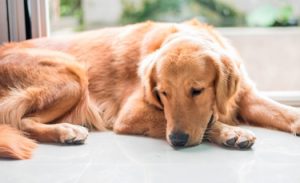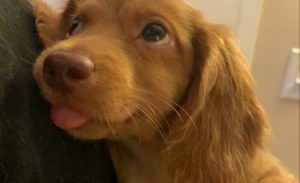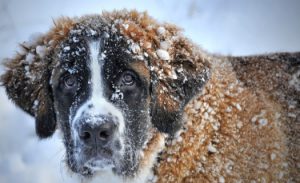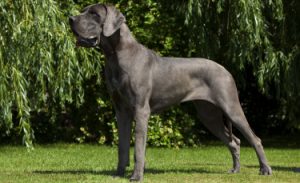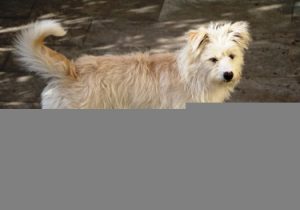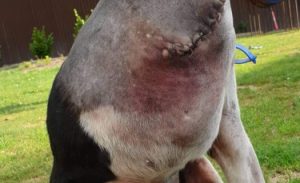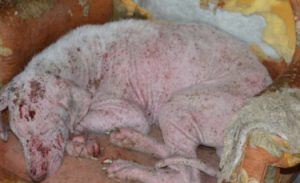Other names: Karjalankarhukoira, Karelian Bear Dog
The Karelian Bear Dog is a Spitz-type, medium-sized, strongly and solidly built hunting dog.
<!–
–>

| Half-long | |
| Finland | |
| Average | |
| Triangular |
| Sex | Weight | Cut |
|---|---|---|
| Female | From 17 kg to 22 kg | From 48 cm to 55 cm |
| Male | From 25 kg to 28 kg | From 53 cm to 60 cm |
History of the breed
the Karelian bear dog would descend from Komi and would have for origins the regions of Karelia-Ladoga, Olonetz and Russian Karelia , straddling the current Finland and Russia. The first structured Karelian Bear Dog breeders were set up in the 1930s . It was during this period that the current name of the breed was adopted. Its first standard was developed at the end of World War II.
Physical features
His hair: thick, smooth and stiff, longer on the neck, back and posterior sides of the thighs. The outer coat is associated with a dense undercoat and a soft texture. The set gives the dog good protection against cold and bad weather.
Its color: dull black or brownish, with well-defined white markings on the head, neck, chest, belly and legs.
His head: The skull is wide (especially between the ears) and slightly convex. The frontal furrow is not very marked, as are the browbones. The stop sign is not either and is gradually arched towards the skull. The nose is broad and black, the muzzle high, the muzzle straight, the lips rather thin, the jaws powerful, well developed and articulated in scissors, the zygomatic arches well developed.
His ears: typically Spitz, being erect and with slightly rounded ends. Medium in size, set high and well apart.
His eyes: of reduced size, of shape tending towards the oval, of brown color and displaying a look full of vivacity.
Its body: slightly longer than high (height at the withers) and therefore writable in a rectangle. The neck is muscular, moderately long and arched. The withers are well extended (more in males), the back straight and muscular, the loins short and strong, the croup wide and slightly oblique, the chest ample, deep and well let down, the ribs slightly arched and the line below a little raised.
Its tail: moderately long, high set and carried in an arch above the back.
Behavior and character
| Affectionate | |
|---|---|
| Calm | |
| Protective | |
| Independent | |
| Hunter | |
| Barks / howls |
Behavior with others
| Cohabitation with children | |
|---|---|
| Sociable with other animals | |
| Love strangers |
the Karelian bear dog is a dog with a balanced temperament . Courageous and determined , he is not aggressive towards males, but males can come into conflict with their peers of the same sex. His keen sense of smell, his remarkable sense of direction and his perseverance are highly appreciated in hunting, an area in which he excels . The Karelian Bear Dog’s favorite game consists mainly of bears (as the name suggests) and elk. He barks vigorously to signal its presence, while holding him close.
The Karelian Bear Dog
is it right for you? Take the test!
Education
| Clever | |
|---|---|
| Obedient |
Obedience and socialization must take place as early as possible in this dog, which is particularly independent and has a very strong territorial sense. His education requires firmness, but without a balance of power.
Living conditions
| Suitable for apartment living | |
|---|---|
| Good for new masters | |
| Love it hot | |
| Love the cold |
the Karelian bear dog is more of a hunting dog than a companion dog. This does not mean that he is incapable of adapting to family life, on the contrary, but it is above all that he is made to hunt and work . It is specifically for this reason that the breed was developed. He can be quite happy in a house with a large fenced garden , as long as he can enjoy long daily outings, ideally in the middle of nature. Its very thick dress does not make it suitable for hot regions.
Health
| Solid | |
|---|---|
| Ease of gaining weight |
The Karelian Bear Dog is a robust dog with a thick, double coat that offers good protection against harsh weather conditions. There is no predisposition to a particular disease in this breed.
Hypoallergenic breed
No
Litter size
Between 4 and 8 puppies
| Major concerns |
|
|||
| Minor concerns |
|
| Suggested tests |
|
To guard against these risks and insure your companion in the event of health problems, Woopets recommends Karelian Bear Dog dog insurance .
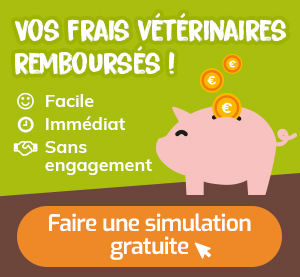
function showAssuranceForm () {var siteReferer = var id_race_association = ”; //console.log(id_race_association);success: function (html) {}});}document.addEventListener (‘DOMContentLoaded’, () => {$ (‘# assuranceModalBanner’). on (‘show.bs.modal’, function (event) {showAssuranceForm ();});});
Life expectancy
Minimum: 10 years
Maximum: 12 years
The life expectancy of a Karelian Bear Dog is, on average, between 10 years and 12 years.
Calculate the human age of your Karelian Bear Dog!
To choose… 1 year 2 years 3 years Four years 5 years 6 years 7 years 8 years 9 years 10 years 11 years old 12 years 13 years 14 years old 15 years old 16 years old 17 years 18 years old 19 years old 20 years 21 years old
Maintenance and hygiene
| Ease of maintenance | |
|---|---|
| Cost of maintenance | |
| Hair loss |
| Drool level | |
|---|---|
| Ease of grooming |
the Karelian bear dog is rather simple to maintain , in particular through regular brushing, but the latter become more supported during molts. These periods are, in fact, marked by fairly significant hair loss.
It is recommended to brush the dog twice a week . During the moult, brushing becomes daily to remove large amounts of dead hair as you go. It can be bathed occasionally . Its hair, ears, eyes and pads should be examined after each outing in the wild to detect and remove any debris or external parasites.
Her teeth need to be brushed regularly to eliminate tartar build-up and the proliferation of bacteria. Finally, if they do not wear out naturally, its claws need to be cut. If you are new to this, it is recommended that you seek advice from a veterinarian or groomer.
Price and budget
Purchase price
Mini
€ 1,100 Maxi
1400 €
The purchase price of a Karelian Bear Dog is between € 1,100 and € 1,400.
Annual maintenance cost
Mini
€ 450 Maxi
650 €
The annual maintenance cost of a Karelian Bear Dog is between € 450 and € 650.
No name is currently proposed. Use our tool to find the name of your Karelian Bear Dog!
Food
The Karelian Bear Dog needs a quality and balanced diet , adapted to its level of physical activity, its size and its age. If it is used for hunting, it should be given special hunting dog food to provide it with all the nutrients it needs. Once the period is over, he can return to a conventional diet.
Want the best for your dog?
Create tailor-made food for your Karelian Bear Dog
I discover !
PROMO -30% | Delivered to you!

Physical activity
| Athletic | |
|---|---|
| Energy level | |
| Potential to play |
the Karelian bear dog needs daily activity and space , with long walks and regular exercise.
Competitions
| Classifications & Standards |
|
Others
| Master character <span class="btnTooltip qTip2" title="- Calm: the master must be gentle and know how to show patience. – Active: the owner must be energetic and dynamic to live in harmony with his dog. – Hyperactive: the owner must be stimulating and very restless to suit the temperament of his dog.”> |
Active |
|---|
We talk on the forum
Polar Bear or Polar Bear
Message from Joo
urgent rescue of a bear !!!!!
Message from solleil
Message from Joo
Coca Cola, decided to help the polar bears
Message from Joo
bam the dog now bam the dog’s revenge
Message from angeacorne
Have a question about the Karelian Bear Dog?
Do not hesitate to ask Woopets visitors for advice on the forum!
FCI Information
FCI No.
48
FCI Group
Group 5: Spitz-type and primitive-type dogs
Recognized by FCI
Since 1954
</div


